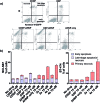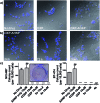Induction of targeted necrosis with HER2-targeted platinum(iv) anticancer prodrugs
- PMID: 28706680
- PMCID: PMC5490001
- DOI: 10.1039/c5sc00015g
Induction of targeted necrosis with HER2-targeted platinum(iv) anticancer prodrugs
Abstract
It is well-recognized that the failure of many chemotherapeutics arises due to an inability to induce apoptosis. Most cancers acquire a myriad of pro-survival adaptations, and the vast heterogeneity and accumulation of multiple often unrelated anti-apoptotic signaling pathways have been a major stumbling block towards the development of conventional chemotherapeutics, which can overcome drug resistance. We have developed highly potent and selective HER2-targeted Pt(iv) prodrugs bearing anti-HER2/neu peptides that induce targeted necrosis as a novel strategy to circumvent apoptosis-resistance. These Pt(iv)-peptide conjugates exhibit a unique biphasic mode of cytotoxicity comprising rapid killing of cancer cells via necrosis in the first phase followed by an extended and gradual phase of delayed cell death. We demonstrate that these Pt(iv)-peptide prodrugs are more potent than their Pt(ii) congeners in direct cell-killing and exhibit comparable long-term inhibition of proliferative capacity and with greater selectivity against HER2-positive cancer cells.
Figures




Similar articles
-
Emerging platinum(iv) prodrugs to combat cisplatin resistance: from isolated cancer cells to tumor microenvironment.Dalton Trans. 2019 Feb 19;48(8):2536-2544. doi: 10.1039/c8dt03923b. Dalton Trans. 2019. PMID: 30633263
-
Antitumoral actions of the anti-obesity drug orlistat (XenicalTM) in breast cancer cells: blockade of cell cycle progression, promotion of apoptotic cell death and PEA3-mediated transcriptional repression of Her2/neu (erbB-2) oncogene.Ann Oncol. 2005 Aug;16(8):1253-67. doi: 10.1093/annonc/mdi239. Epub 2005 May 3. Ann Oncol. 2005. PMID: 15870086
-
Effective platinum(IV) prodrugs conjugated with lonidamine as a functional group working on the mitochondria.J Inorg Biochem. 2018 Mar;180:119-128. doi: 10.1016/j.jinorgbio.2017.11.017. Epub 2017 Nov 21. J Inorg Biochem. 2018. PMID: 29253663
-
Recent Approaches to Platinum(IV) Prodrugs: A Variety of Strategies for Enhanced Delivery and Efficacy.Curr Pharm Des. 2017;23(16):2366-2376. doi: 10.2174/1381612823666170201161037. Curr Pharm Des. 2017. PMID: 28155621 Review.
-
Multi-action Pt(IV) anticancer agents; do we understand how they work?J Inorg Biochem. 2019 Feb;191:77-84. doi: 10.1016/j.jinorgbio.2018.11.008. Epub 2018 Nov 15. J Inorg Biochem. 2019. PMID: 30471522 Review.
Cited by
-
Pt(IV) Complexes in the Search for Novel Platinum Prodrugs with Promising Activity.Top Curr Chem (Cham). 2024 Feb 24;382(1):6. doi: 10.1007/s41061-023-00448-3. Top Curr Chem (Cham). 2024. PMID: 38400859 Review.
-
Analysis of Antiangiogenic Potential and Cell Death Mechanism of a Kinetically Inert Platinum Antitumor Agent.ACS Med Chem Lett. 2024 Aug 19;15(9):1482-1490. doi: 10.1021/acsmedchemlett.4c00207. eCollection 2024 Sep 12. ACS Med Chem Lett. 2024. PMID: 39291013
-
Leucine aminopeptidase may contribute to the intrinsic resistance of cancer cells toward cisplatin as revealed by an ultrasensitive fluorescent probe.Chem Sci. 2016 Jan 1;7(1):788-792. doi: 10.1039/c5sc03600c. Epub 2015 Oct 22. Chem Sci. 2016. PMID: 28966770 Free PMC article.
-
A New Method Without Organic Solvent to Targeted Nanodrug for Enhanced Anticancer Efficacy.Nanoscale Res Lett. 2017 Dec;12(1):416. doi: 10.1186/s11671-017-2174-x. Epub 2017 Jun 15. Nanoscale Res Lett. 2017. PMID: 28622716 Free PMC article.
-
Advances in platinum-based cancer therapy: overcoming platinum resistance through rational combinatorial strategies.Med Oncol. 2025 Jun 16;42(7):262. doi: 10.1007/s12032-025-02812-3. Med Oncol. 2025. PMID: 40518502 Free PMC article. Review.
References
-
- Teicher B. A., in Molecular Cancer Therapeutics: Strategies for Drug Discovery and Development, John Wiley & Sons, Inc., 2005, pp. 7–40.
-
- Gerlinger M., Rowan A. J., Horswell S., Larkin J., Endesfelder D., Gronroos E., Martinez P., Matthews N., Stewart A., Tarpey P., Varela I., Phillimore B., Begum S., McDonald N. Q., Butler A., Jones D., Raine K., Latimer C., Santos C. R., Nohadani M., Eklund A. C., Spencer-Dene B., Clark G., Pickering L., Stamp G., Gore M., Szallasi Z., Downward J., Futreal P. A., Swanton C. N. Engl. J. Med. 2012;366:883–892. - PMC - PubMed
-
- Galluzzi L., Vitale I., Vacchelli E., Kroemer G. Front. Oncol. 2011 doi: 10.3389/fonc.2011.00005. - DOI - PMC - PubMed
- Dinnen R. D., Drew L., Petrylak D. P., Mao Y., Cassai N., Szmulewicz J., Brandt-Rauf P., Fine R. L. J. Biol. Chem. 2007;282:26675–26686. - PubMed
- Hu X., Xuan Y. Cancer Lett. 2008;259:127–137. - PubMed
-
- Rubin I., Yarden Y. Ann. Oncol. 2001;12:S3–S8. - PubMed
LinkOut - more resources
Full Text Sources
Other Literature Sources
Research Materials
Miscellaneous

